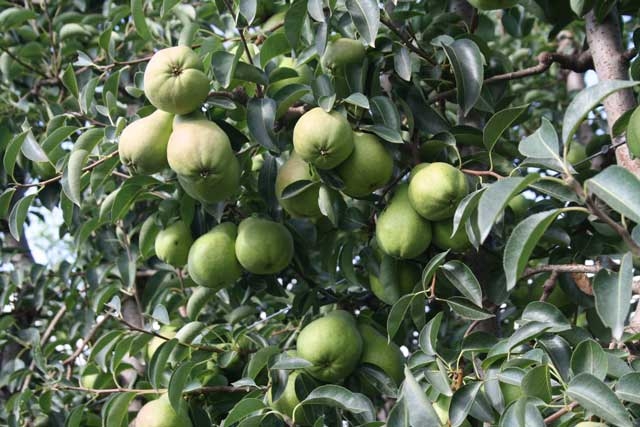In the early 20th century, researchers in California, Germany, South Africa and Australia reported that Williams’ fruit had no seeds.
The full name of the variety, Williams’ Bon Chretien, is also referred to as WBC or Bartlett.
The term parthenocarpy was introduced, and is defined as the development of fruit without fertilisation of the ovules. Fruit can set and grow to full size without fertilisation.
Two forms are distinguishable:
• Vegetative parthenocarpy—fruit set and development without pollination or fertilisation
• Stimulative parthenocarpy—fruit set and development with pollination but without fertilisation, also called self-pollination.
In some seasons in Australia, vegetative parthenocarpy was evident, while in other seasons stimulation of self-pollination appeared necessary for high fruitfulness.
Williams’ trees set heavy commercial crops of parthenocarpic pears under favourable conditions (as in California, South Africa and Australia), but fail to set commercial crops without cross-pollination in other countries and locations. Hence this variety has been classified as self-fertile in one part of a country and self-sterile in another.
Parthenocarpy in pears
Although some parthenocarpy is observed in many species of temperate fruits, it is most widespread in pears.
The rate of parthenocarpic fruit set is genetically determined among pear varieties, but is greatly affected by management and the environment.
For example, Williams’ trees needed fertilisation for fruit set in the eastern US, but was parthenocarpic in California.
In South Australia, cross-pollination was not essential, but it was in southern Victoria.
Cross-pollination for higher fruit set
Most research on pollination and fruit set in Williams’ agrees that cross-pollination leads to higher fruit set than does self-pollination.
This is further supported in orchards in California that had high fruit sets and high yields of parthenocarpic fruit for many years. These orchards were interplanted with polliniser trees and beehives were placed in the orchards during flowering.
Fruit set of Williams’ pears
The fruit of Williams’ can develop without the need of fertilisation from pollen grains. However, pollination, fertilisation and fruit set of Williams’ remain controversial subjects.
Research has shown that interplanted polliniser trees together with beehives placed in orchards during flowering, lead to cross-pollination and hence high yields of Williams’ pears.
As early as 1967, cross-pollination was reported to increase both fruit set and fruit size in Williams’ in the Goulburn Valley.
Beurre Bosc (Bosc) pear was the traditional interplanted polliniser for Williams’. However, it was almost impossible to manage interplanted Bosc because copper sprays were needed to make the skin of the Bosc pears brown (russet), while Williams’ had to remain russet-free.
It was later discovered that the nashi variety Nijisseiki was a much better polliniser.
As interplanted trees, the fruit of Nijisseiki has no market value because the fruit are not thinned.
Effect of temperature at flowering on fruit set (cont. next issue)
See this article in Tree Fruit Oct 2020






















